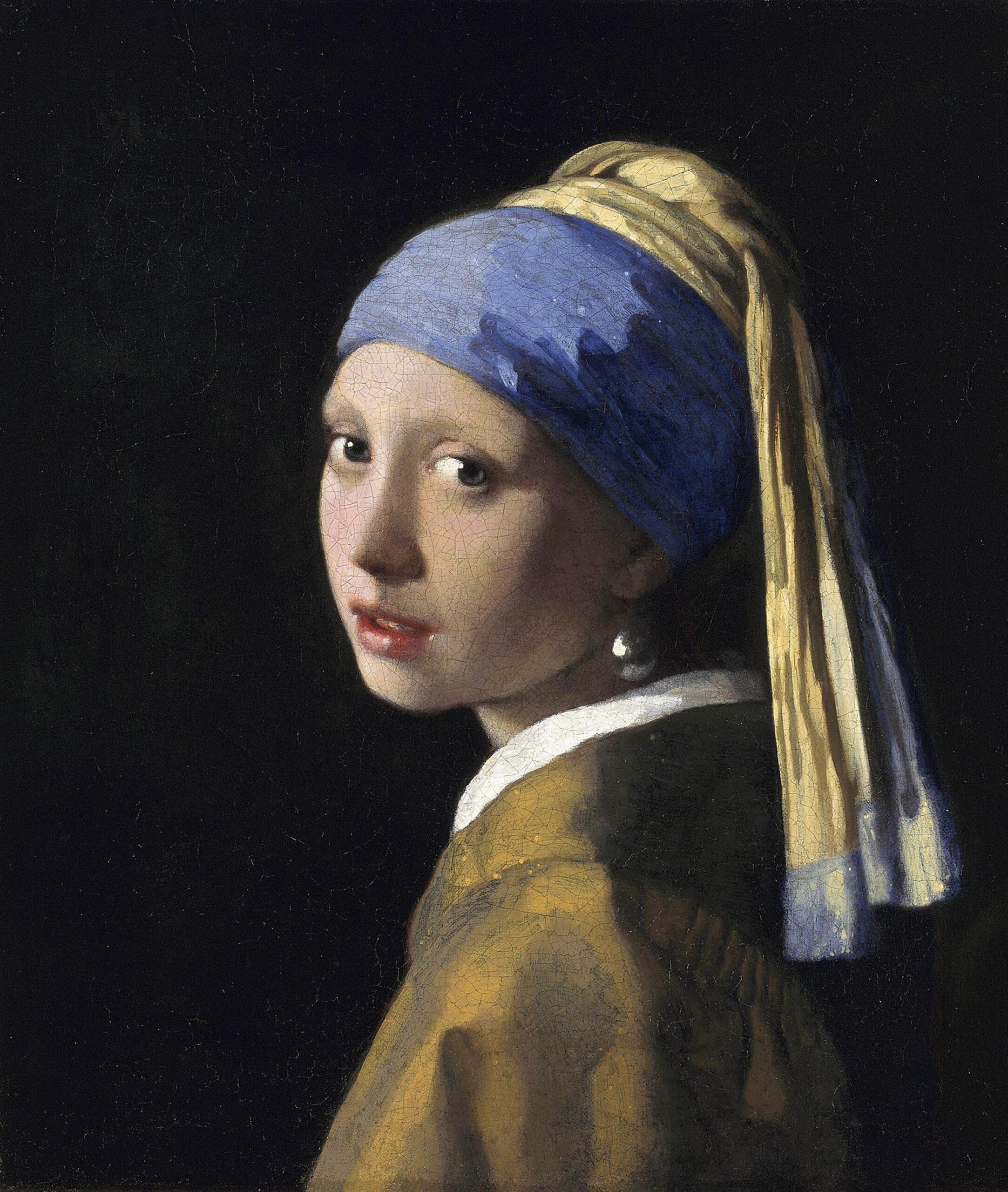Author: Megan Poole
Season 3 Ep 12: Goya, The Duchess of Alba
Johannes Vermeer’s treatment of love distinguished him from his peers…
I’m happy to post another article from my friend Joseph Phelan, who is an excellent art critic based in the USA. As today we have just finished our VERMEER: THE GREATEST EXHIBITION film, it seems the perfect time to post this. – Phil
Portrayals of Love
Johannes Vermeer’s treatment of love distinguished him from his peers.

Johannes Vermeer, the seventeenth-century Dutch artist of the “fine painter” school, led a private life. He rarely left his hometown, Delft; exceedingly little is known about him apart from the fact that he married a Catholic woman, may have converted to her faith, and had eleven surviving children. He apparently produced only two paintings a year for two decades. After his death, Vermeer passed into near-oblivion for almost two centuries. In the latter part of the nineteenth century, however, Vermeer’s star began to rise again, and it has not stopped rising since. In recent years, Vermeer’s popularity has only grown, thanks to the work of contemporary art historians and the sensibility of modern audiences.
Georgievska-Shine’s book has two parts. In the first part, she gives us a tour of Dutch genre painting in the mid-seventeenth century, showing how this artistic culture shaped Vermeer’s subject matter, characters, and situations. In the second, “Vermeer’s Difference,” she convincingly argues that “his visions of that Dutch reality seem a world apart from” those of his fellow painters. His marked superiority to most Dutch painters of his time was less in technical virtuosity than in form and meaning.
A quick first survey of his works can give the impression that Vermeer was primarily a genre painter whose main interest was women in domestic life—writing and reading letters, knitting, playing a musical instrument, and the like.
Like other contemporary scholars of seventeenth-century Dutch art, Georgievska-Shine shows that there is much more to Vermeer than that. Her objective in Vermeer and the Art of Love is to explore Vermeer’s wide-ranging, deeply revealing artistic treatment of the subject of love—love between a man and a woman and between man and God—together with its connections to poetry, music, and perhaps above all the visual arts.
The Vermeers she discusses depict women sometimes in moments of solitude—tuning or playing a musical instrument or reading or writing a letter, possibly from or to her lover—at other times in the presence of an actual or would-be lover, each time revealing some distinct aspect of the love relationship. The excited anticipation of the satisfaction of erotic desire to come, the wistful longing for her lover in his absence, the growing thrill of seduction by a music teacher or a soldier who comes calling, and above all, divine love—these are just a few of the emotions and ideas associated with love that are subtly but powerfully expressed through Vermeer’s expert use of form and symbolism in his paintings.
According to Georgievska-Shine, one especially noteworthy aspect of Vermeer’s treatment of love is his undogmatic, non-moralizing approach to the subject. In this respect, he is distinctly different from other prominent contemporary Dutch artists, among them Jan Steen, who is preoccupied with eros outside the bounds of morality, and Pieter de Hooch, who often portrays morally upright eros.
Take, for example, Officer and Laughing Girl. The foregrounded, largely silhouetted figure of the soldier, his back to the viewer, that dominates the painting’s composition engenders, says Georgievska-Shine, “an air of mystery.” We are uncertain whether he is a hunter or conqueror attempting to seduce an unsuspecting young girl at the moment, so to speak, or a genuine Petrarchan courtier seeking but failing to bind himself for all time with his beloved. The redness of his coat bespeaks a robust erotic passion in him, which he may be seeking to satisfy immediately by charming her—successfully, judging by the apparent expression of delight on her face—with accounts of his adventures abroad possibly limned in the map hanging on the wall in the background (a leitmotif of Vermeer’s paintings).
Alternatively, the same map might be taken as a metaphor: a “map of love,” a source of guidance for the lover in his “journey to the heart of the beloved.” Instead of forcing the viewer to choose between these two interpretations of the soldier’s intentions and the moral implications of each, Vermeer, says Georgievska-Shine, has our attention focused on the pure joy in his company the girl clearly evinces, making us wonder what she is “listening to or … imagining” as he speaks. We are oblivious to the likelihood of her virtue being compromised in Vermeer’s painting, in stark contrast to Pieter de Hooch’s A Couple Playing Cards, with a Serving Woman, wherein, Georgievska-Shine argues, the signs all point unmistakably to a morally dubious outcome.
A pervasive theme of Georgievska-Shine’s discussion is Vermeer’s elusiveness and secretiveness. Consider his use in several paintings of such a seemingly innocuous object as a curtain. To return to the Girl Reading a Letter, the curtain on the right side of the picture frame conceals what Cupid is holding in his upraised left hand. Some visual images of Cupid in Vermeer’s time, such as a couple of engravings by Otto van Veen, depict him as “holding up a tablet inscribed with the number one, proclaiming the mutual devotion of lovers.” In others, by contrast, he holds up the ring of Gyges, reminding us of the lover’s capacity for duplicity. Because Cupid’s left hand is hidden behind the curtain in the painting, we do not know whether it is holding “the magic ring of duplicity or the card of faithfulness.” The artist deliberately prevents us from ascertaining with certainty the nature and moral quality of the love relationship in question.
To be sure, Cupid is also shown with “two masks at his feet.” Since, as Georgievska-Shine argues, the masks are meant to symbolize deception, it is “as if the artist wanted to make sure the beholder will understand his message” as one of true devotional love. Yet we cannot be sure, if only because of the love god’s concealed left hand. (Although Georgievska-Shine then develops the further argument that the allusion to Gyges’ ring may signify “the deceptiveness of images,” such as Vermeer’s painting itself, and at the same time point to us beholders as “invisible,” “clandestine” Gyges-like figures gazing lovingly at the “beautiful illusion [of a woman] that the painter has created for us.”)
In Allegory of the Catholic Faith, the overarching theme of which is divine love, we see foregrounded on the left a tapestry curtain with all kinds of “largely illegible forms,” which Georgievska-Shine describes as a “woven ‘text’ that simultaneously uncovers and obscures the larger image.” One of those “forms” is an image, largely obscured by the curtain’s folds, of a “rider on horseback.” Owing to the allegorical nature of the painting, one can safely infer that the rider is St. Paul and that the curtain is thus “hinting at the Pauline obscurity of vision” spoken of in 1 Corinthians 13:12 (“For now we see in a mirror dimly, but then face to face. Now I know in part; then I shall understand fully, even as I have been fully understood”).
Georgievska-Shine wonders whether the image is a “metaphor for a spiritual journey.” Upon further analysis of the painting’s symbolism, the spiritual journey proves, in her view, to be that of Catholics residing in a country where Calvinism is the established religion, who must gather together for prayer and worship in “secret” places. The presence of hidden meanings in Allegory symbolized by the curtain is confirmed by, among other things, the glass orb hanging from the ceiling, to which the gaze of the central figure—whom Georgievska-Shine describes as a fusion of Mary and Mary Magdalene and christens “Faith”—is directed: Barely visible on the orb is a reflection of a “partially open window, possibly another signal of the veiled nature of knowledge.” The “reflective surface” of the orb, Georgievska-Shine goes on to argue, can be understood to signify, in a veiled, metaphorical way, the painting in its entirety “as a Pauline mirror that guides us from the visible towards that which defies understanding: the metaphysics of love.”
One may again come away from a first encounter with Vermeer’s paintings thinking that in them form ministers to a purely naturalistic artistic aim: Formal elements of art such as line, color, texture, and shading are used to make the contents of the painting resemble, with near-photographic accuracy, things as we experience them in everyday life. However, as Georgievska-Shine points out, attentive observation discloses a strong “classicizing” tendency continuous with that of the Renaissance. The near-geometrical organization of the contents of his paintings along clearly recognizable vertical and horizontal lines, one of those classicizing features, prefigure the geometrical abstractions of twentieth-century Dutch modernist Piet Mondrian, for instance, his Broadway Boogie Woogie. But in Vermeer’s case, classical form and order are made to serve the visual expression of higher human meanings, such as man’s love of God, that cohere with a Christianity touched by neoplatonic philosophy. His artwork shows how the beauty of classical form and harmony can “affect our soul” in an edifying way.
Some of Georgievska-Shine’s interpretations may strike the reader as doubtful, unclear, or far-fetched. But so erudite, detailed, and finely honed is her argument that intellectual integrity obliges us to carefully reread the entire book to ensure that such doubts do not stem from misunderstandings on our part.
Georgievska-Shine’s book brings to light love’s many-sidedness and complexity—with stress on its more uplifting aspects—in Vermeer’s rich visual portrayals. Mirroring Vermeer’s artistic intention, which coincides with a more traditional, common-sense perspective on the subject, and contrary to the contemporary taste for debunking, Georgievska-Shine stands firmly on the essential and irreducible distinction between spiritual (or noble) and corporeal (or base) eros.
Season 3 Ep 11: Albrecht Drürer, Great Piece of Turf
Season 3 Ep 10: Vermeer, Girl Reading a Letter by an Open Window
“My Lifetime May be Finite, But My Curiosity is Infinite”
Filming the Vermeer exhibition at the Rijksmuseum for Vermeer: The Greatest Exhibition.
Hi! Here are just some of the reviews that have just come out for this exhibition:
It’s a miracle. Unmissable – The Guardian
Unmissable – ArtNet
Don’t miss it! – AOL
Momentous, dizzying, unrepeatable – The Financial Times
Breathtaking – A once-in-a-lifetime experience – The Times
A once-in-a-lifetime opportunity – American Magazine
The biggest Vermeer exhibition of this, or any other, lifetime – CNN
There will never be another Vermeer show as great as this one – Washington Post
One of the most thrilling exhibitions ever! – The Observer
A blockbuster – CNN
Practically perfect- A show more precious than pearls – New York Times
I don’t know about you but those alone would make me want to get on the next Eurostar to Amsterdam and queue for tickets (if it’s not sold out already).
We, however, had a privileged look before it opened. This kind of access doesn’t come without a lot of work but, after a couple of years staying in contact with our friends at the wonderful Rijksmuseum, a few days ago, we entered the building as the sole camera team given access to fully film the show – all 28 iconic Vermeer paintings – 75% of his entire existing oeuvre. No-one has ever had so many Vermeers in one place – not even him. And it is spectacular.
The museum curators and teams have done a really tremendous job of the hang – details like the background wall colour, the curtains that hang down, the positioning of the wall captions, even the modest size of the shop, all these things are, in my opinion, spot on. But it’s the paintings that sing out. I had the luck to look at each of them on my own – you, if you go, will have many other folk around you but it won’t take long to find a position to look into the paintings and the storytelling that lies within.
I had the privilege too of having six great experts to interview and, honestly, it was so interesting I could have talked to each one of them for the entire day. I read a phrase the other day which rang true with me: ‘my lifetime may be finite, but my curiosity is infinite’. They say Vermeer is a man of mystery, ‘The Enigma of Delft’. Well, actually, there is a lot that can be said, a lot that can be surmised, and a lot that can be divined simply from looking hard at the paintings.
We didn’t finish filming until the early hours – and then went back in the next day for more. We’re busy editing now to get the film out to cinemas from 18th April. My advice? See the film then see the show, then see the film again….Vermeer is worth it.
Oh, and by the way, while I was there, I did a podcast with Tracy Chevalier (writer of GIRL WITH A PEARL EARRING). Check it on our the podcast, Painting of the Week: https://seventh-art.com/podcast/
Phil Grabsky and Tracy Chevalier stand in front of ‘Girl Reading a Letter at an Open Window’, Vermeer (c. 1657–1659).
I am forever in awe of the quality and breadth and power of documentaries
It is possible that, once or twice, I’ve had a moan in my blogs about the state of documentary filmmaking or the distribution channels open to films or the paltry licence fees broadcasters pay for films. I’ve certainly said publicly many times that I consider the documentary film industry to be, if not structurally flawed, then certainly far from sound. How can I spend years on a film and be offered a few thousand dollars for it by a national broadcaster? The same national broadcaster that will spend millions on a Saturday night game show or a game of football? So I am forever in awe of the quality and breadth and power of the many documentaries that somehow do get made. Right now I am watching (as a BAFTA voter) the documentaries that have been entered in the BAFTA film awards. It is slightly confusing but you have a documentary award in the film awards and a Best Single Documentary award in the TV awards. (That’s the one we won last year). In theory this is distinguishing between those films made for the cinema and those for TV but most docs made for the cinema are made with TV money and for TV ultimately. I guess one thing that distinguishes them is that the Film Award docs tend to be 90’-ish and the TV docs 30’ or 60’ though some -like mine – are 90’. Anyway, in the Film Awards this year there were 56 films entered and, overall, they were far more interesting than many of the fiction films. I rarely saw a bad documentary whereas over the past few weeks I have watched plenty of truly feeble fiction films. Nothing really beats real life – whether it is the life of British artist Ravillious, or the treatment in Saudi Arabia of repatriated Guantanamo prisoners, or a small film-makers’ club in Bradford. With the horrors ongoing in Afghanistan, Syria, Yemen and of course poor Ukraine – to name just a few – I don’t really want to watch poorly made Hollywood nonsense when I can watch brilliantly made docs about real people and real situations. So here follows the list of the 10 docs that have made the longlist – I recommend them all. I have my couple of favourites but obviously can’t reveal that. Whichever one ultimately wins, it’s a bit of bunfight, but it will reflect a filmmaking community that somehow – really, how are you all doing it? Is it just Netflix and Apple monies?? – is in good shape. If only the world’s politicians would watch them and act accordingly!!





